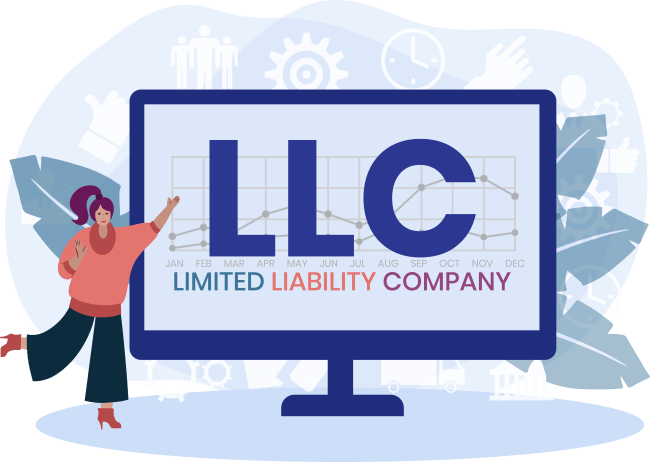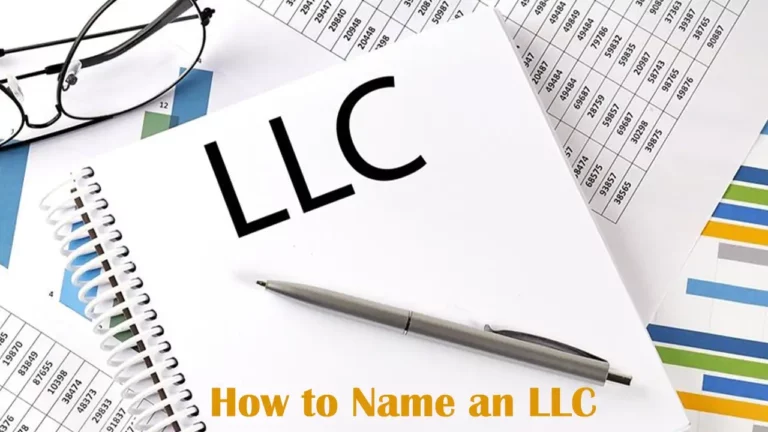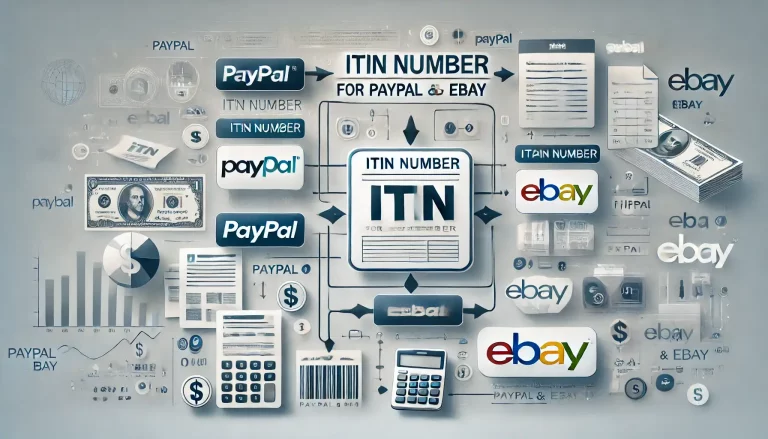Understanding the Benefits of an LLC
Starting a business involves many crucial decisions, and choosing the right structure is key. A Limited Liability Company (LLC) is a popular choice, offering the simplicity of a partnership or sole proprietorship with the liability protection of a corporation. This comprehensive guide explores the benefits of an LLC, including limited liability protection, tax flexibility, and ease of management. Whether you’re a new entrepreneur or considering restructuring, understanding the advantages of an LLC will help you make an informed decision.
Table of Contents

What is an LLC?
Defining a Limited Liability Company (LLC)
A Limited Liability Company (LLC) is a flexible business structure that combines elements of both a corporation and a partnership or sole proprietorship. It provides the liability protection typically associated with a corporation while offering the operational flexibility and tax advantages found in partnerships or sole proprietorships. This hybrid nature makes LLCs particularly attractive to small business owners and entrepreneurs who seek to protect their personal assets without the complexities of managing a corporation.
Key Characteristics of an LLC:
- Limited Liability: The most significant feature of an LLC is the limited liability protection it offers. This means that the personal assets of the LLC members (owners) are generally protected from business debts and liabilities. If the LLC faces legal action or bankruptcy, members’ personal assets such as homes, cars, and personal savings are typically not at risk.
- Flexible Management Structure: LLCs offer flexibility in management. They can be either member-managed, where all members participate in running the business, or manager-managed, where specific individuals (who may or may not be members) are designated to manage the operations.
- Pass-Through Taxation: One of the appealing aspects of an LLC is its tax treatment. By default, LLCs benefit from pass-through taxation, meaning that the LLC itself does not pay taxes on its income. Instead, profits and losses are reported on the personal tax returns of the members, avoiding the double taxation often seen in corporations.
- Fewer Formalities: Compared to corporations, LLCs require fewer formalities. There are generally no requirements for holding annual meetings, maintaining detailed records, or issuing stock. This makes LLCs easier to operate, especially for small businesses.
Comparison with Other Business Structures:
| Feature | LLC | Sole Proprietorship | Partnership | Corporation |
|---|---|---|---|---|
| Liability Protection | Limited liability for members | No liability protection | Limited liability for partners | Limited liability for shareholders |
| Taxation | Pass-through (default) | Pass-through | Pass-through | Double taxation (unless S-Corp) |
| Management | Flexible (member or manager-managed) | Sole owner management | Partners manage | Board of directors required |
| Formation | State filing required | No formal filing required | State filing required (if LLP) | State filing and bylaws required |
| Compliance Requirements | Minimal | Minimal | Varies by partnership type | Extensive |
How is an LLC Formed?
Forming an LLC involves several steps, and while the process can vary by state, the general procedure includes:
- Choosing a Name: The first step is selecting a unique name for the LLC that complies with state regulations, including the requirement to include “LLC” or “Limited Liability Company” in the name.
- Filing Articles of Organization: This is a legal document filed with the state in which the LLC is being formed. It includes basic information such as the LLC’s name, address, and the names of its members.
- Creating an Operating Agreement: Although not always required, an Operating Agreement is a critical document that outlines the management structure, roles, and responsibilities of the members. It can be tailored to suit the specific needs of the business.
- Obtaining an EIN: The LLC needs an Employer Identification Number (EIN) from the IRS for tax purposes, even if it doesn’t plan to hire employees.
- Complying with Local Requirements: Depending on the state, there may be additional requirements, such as publishing a notice of the LLC formation in a local newspaper or obtaining specific business licenses.

Key Benefits of an LLC
Limited Liability Protection
One of the most compelling reasons to form an LLC is the limited liability protection it offers to its members. This benefit ensures that the personal assets of the LLC’s owners are typically shielded from the company’s debts and legal liabilities. Let’s explore how this works and why it’s so important for business owners.
Protecting Personal Assets
When you operate a business as a sole proprietor or a general partnership, you are personally liable for all the debts and obligations of your business. This means that if your business faces a lawsuit, creditors can go after your personal assets, including your home, car, and savings. However, with an LLC, your personal assets are generally protected. The LLC is considered a separate legal entity, so only the assets owned by the business are at risk.
Scenarios Where Limited Liability Protection is Crucial:
- Lawsuits: If your LLC is sued due to a breach of contract, negligence, or other legal disputes, the claimants can typically only go after the business assets, not your personal property.
- Business Debts: If your LLC incurs debt or defaults on a loan, creditors can pursue the company’s assets, but your personal wealth remains protected.
- Bankruptcy: In the unfortunate event that your LLC declares bankruptcy, your personal assets are usually safe from being used to satisfy the company’s debts.
This protection is not absolute, however. In certain circumstances, known as “piercing the corporate veil,” courts can hold LLC members personally liable if they fail to maintain the proper separation between personal and business finances, commit fraud, or act in a way that disregards the LLC’s legal status.
Credibility with Limited Liability
In addition to protecting your personal assets, forming an LLC can also enhance your business’s credibility. Operating as an LLC signals to clients, vendors, and partners that your business is a legitimate, professional entity. This can be especially important when trying to secure contracts, attract investors, or build partnerships.
- Client Trust: Clients may feel more confident working with an LLC, knowing that it is a recognized business structure that adheres to certain legal and financial standards.
- Vendor Relationships: Vendors and suppliers often prefer to do business with an LLC over a sole proprietorship because it demonstrates a level of seriousness and commitment to the business.
- Partnerships and Investments: Potential partners and investors are more likely to engage with a business that has a formal structure like an LLC, as it suggests the business is stable and well-organized.
Summary of Limited Liability Protection:
| Aspect | LLC | Sole Proprietorship |
|---|---|---|
| Personal Asset Protection | Yes, typically protected | No, personal assets at risk |
| Business Credibility | Higher due to formal structure | Lower due to lack of formal structure |
| Liability in Legal Disputes | Limited to business assets | Personal assets fully exposed |
| Impact on Partnerships/Investors | Positive, seen as more stable | Negative, seen as less formal |
The limited liability protection offered by an LLC is a cornerstone of why many entrepreneurs choose this business structure. It provides peace of mind by safeguarding personal assets while also enhancing the business’s professional image.

Tax Flexibility
Another major advantage of forming an LLC is the tax flexibility it offers. Unlike corporations, which are subject to double taxation, LLCs provide multiple options for how they are taxed, allowing business owners to choose the most advantageous tax structure for their specific situation. Let’s dive into the details of these tax benefits and how they can impact your business.
Pass-Through Taxation
By default, an LLC benefits from pass-through taxation, which means that the LLC itself does not pay federal income taxes. Instead, profits and losses “pass through” the business to the owners, who report them on their personal tax returns. This can be a significant advantage for many business owners, especially those who want to avoid the double taxation that affects C-Corporations.
How Pass-Through Taxation Works:
- Single-Member LLC: If you are the sole owner of the LLC, the IRS treats your business as a “disregarded entity” for tax purposes. This means that your LLC’s income and expenses are reported on your personal income tax return using Schedule C. You are only taxed once, on your personal income.
- Multi-Member LLC: In a multi-member LLC, the IRS treats the business as a partnership by default. The LLC itself does not pay taxes; instead, each member reports their share of the profits and losses on their personal tax returns using Form 1065. Each member receives a Schedule K-1 showing their share of the LLC’s income, deductions, and credits.
Benefits of Pass-Through Taxation:
- Avoiding Double Taxation: Unlike C-Corporations, which are taxed at both the corporate level and again on shareholders’ dividends, LLCs avoid this by passing income directly to the owners.
- Simplified Tax Reporting: For single-member LLCs, tax reporting is straightforward and requires only a few additional forms on the owner’s personal tax return.
- Deductible Business Expenses: LLC owners can deduct legitimate business expenses on their personal tax returns, reducing their overall taxable income.
Flexibility in Tax Classification
One of the unique benefits of an LLC is the ability to choose how the business is taxed. While the default is pass-through taxation, LLCs have the option to elect different tax classifications with the IRS. This flexibility allows business owners to select the tax treatment that best suits their financial goals and business operations.
Tax Classification Options for LLCs:
- Sole Proprietorship (Single-Member LLCs): By default, a single-member LLC is taxed as a sole proprietorship, with income reported on the owner’s personal tax return.
- Partnership (Multi-Member LLCs): Multi-member LLCs are taxed as partnerships by default, with income distributed among members based on ownership percentages.
- S-Corporation: An LLC can elect to be taxed as an S-Corporation by filing Form 2553 with the IRS. This option allows the LLC to benefit from pass-through taxation while potentially reducing self-employment taxes on the owner’s salary.
- C-Corporation: Although less common, an LLC can choose to be taxed as a C-Corporation by filing Form 8832. This option might be beneficial for businesses planning to reinvest profits back into the company or those seeking to attract investors who prefer the C-Corporation structure.
Example of Tax Classification Decision:
- Scenario: A single-member LLC owner expects significant profits this year and wants to minimize self-employment taxes. The owner might consider electing S-Corporation status, allowing them to take a reasonable salary (subject to payroll taxes) and receive the remaining profits as distributions, which are not subject to self-employment taxes.
Comparison of Tax Options:
| Tax Classification | Advantages | Disadvantages |
|---|---|---|
| Sole Proprietorship | Simple tax filing, no corporate taxes | Full self-employment tax |
| Partnership | Flexible profit distribution | Joint liability for taxes |
| S-Corporation | Reduced self-employment tax | More complex tax filing and payroll requirements |
| C-Corporation | Corporate tax benefits | Double taxation on dividends |
The ability to choose how your LLC is taxed gives you the power to optimize your tax situation based on your business needs and financial goals. This flexibility is a key reason why many business owners prefer the LLC structure over others.
Simple and Flexible Management Structure
One of the standout features of an LLC is its simple and flexible management structure. This flexibility allows business owners to choose how they want to manage their company, making it an attractive option for both small businesses and larger enterprises. Whether you prefer a hands-on approach or want to delegate management responsibilities, an LLC can be tailored to suit your needs.
Member-Managed vs. Manager-Managed LLCs
LLCs offer two primary management structures: member-managed and manager-managed. Each structure has its own advantages and is suitable for different types of businesses.
- Member-Managed LLC:
- Definition: In a member-managed LLC, all members (owners) are actively involved in the day-to-day operations of the business. This structure is common in smaller businesses where the owners want to maintain control and directly manage the company.
- Advantages:
- Direct Control: Members have a hands-on role in decision-making and operations, which can lead to quicker decisions and more direct oversight.
- Cost-Effective: Since there are no additional management layers, this structure can be less expensive to operate.
- Transparency: All members have a clear understanding of the business’s financial health and operational challenges.
- Disadvantages:
- Time-Consuming: Active involvement in management can be time-consuming, especially for members who have other responsibilities.
- Potential for Conflict: When multiple members are involved in management, disagreements can arise, potentially leading to conflicts.
- Best For: Small businesses, family-owned businesses, or partnerships where all owners want to be actively involved.
- Manager-Managed LLC:
- Definition: In a manager-managed LLC, the members appoint one or more managers to handle the day-to-day operations of the business. These managers may be members of the LLC, but they can also be external professionals hired to manage the company.
- Advantages:
- Delegation of Responsibilities: Members can delegate management duties to appointed managers, allowing them to focus on other aspects of the business or personal ventures.
- Expertise: Hiring professional managers can bring specialized skills and expertise to the business, potentially improving operations and growth prospects.
- Less Conflict: By centralizing management in a smaller group, there may be fewer disagreements among members.
- Disadvantages:
- Less Control: Members may have less direct control over the day-to-day decisions, which could be a disadvantage for those who want to be more hands-on.
- Additional Costs: Hiring external managers can increase operational costs, especially if the managers are compensated with salaries and bonuses.
- Best For: Larger businesses, businesses with passive investors, or owners who prefer to focus on high-level decisions rather than daily operations.
Comparison of Management Structures:
| Aspect | Member-Managed LLC | Manager-Managed LLC |
|---|---|---|
| Control | Direct, hands-on by all members | Delegated to managers |
| Decision-Making | Collaborative among members | Centralized with managers |
| Time Commitment | High, requires active involvement | Lower for members, higher for managers |
| Expertise Required | Dependent on members’ skills | Can bring in external expertise |
| Cost | Lower operational costs | Higher due to management compensation |
Flexibility in Setting Up Management Structures
The flexibility of an LLC extends beyond just choosing between member-managed and manager-managed structures. LLCs allow for the creation of customized management structures tailored to the specific needs and goals of the business. This can be particularly beneficial as the business grows and evolves.
Customizable Operating Agreement:
- Role Definitions: An LLC’s Operating Agreement can define specific roles and responsibilities for each member or manager, ensuring clarity and avoiding overlaps in duties.
- Voting Rights: The Operating Agreement can establish how voting rights are allocated among members, which can be based on ownership percentages or other criteria.
- Decision-Making Processes: The document can outline the processes for making major business decisions, such as requiring a majority or unanimous vote for certain actions.
- Profit Distribution: LLCs offer flexibility in how profits are distributed among members. The Operating Agreement can specify different profit-sharing arrangements based on contributions or other factors.
Example of a Flexible Management Structure:
- Scenario: A tech startup LLC has three founding members, each with different expertise—one in technology, one in marketing, and one in finance. The Operating Agreement designates the tech-savvy founder as the Chief Technology Officer (CTO) with control over product development, the marketing expert as the Chief Marketing Officer (CMO) with control over customer acquisition strategies, and the finance expert as the Chief Financial Officer (CFO) overseeing financial management. This structure leverages each member’s strengths while providing a clear division of responsibilities.
Minimal Compliance Requirements
One of the significant advantages of forming an LLC is the minimal compliance requirements compared to other business structures, such as corporations. LLCs are designed to be straightforward to manage, with fewer mandatory formalities, making them an ideal choice for small business owners and entrepreneurs who want to focus more on running their business and less on regulatory obligations.
Fewer Formalities Compared to Corporations
Corporations, especially C-Corporations, are subject to a variety of strict formalities and regulatory requirements, which can be time-consuming and costly. In contrast, LLCs are much simpler to operate, with fewer mandatory formalities.
Key Differences in Compliance Requirements:
- Annual Meetings: Corporations are generally required to hold annual shareholder meetings and keep detailed minutes of these meetings. LLCs, on the other hand, are not required to hold annual meetings unless stipulated by the Operating Agreement.
- Board of Directors: Corporations must establish and maintain a Board of Directors, which oversees the company’s operations and makes significant decisions. LLCs do not require a Board of Directors, allowing for a more streamlined decision-making process.
- Record Keeping: While corporations are required to maintain extensive records, including bylaws, meeting minutes, and shareholder agreements, LLCs have much simpler record-keeping requirements. Typically, an LLC needs to maintain its Operating Agreement and keep accurate financial records.
- Reporting Requirements: Corporations are often subject to more frequent and detailed reporting to regulatory bodies, such as filing annual reports, submitting financial statements, and adhering to strict disclosure requirements. LLCs, in contrast, usually have fewer reporting obligations, which can vary by state.
Simplified Annual Reporting
Although LLCs have fewer compliance requirements, most states do require some form of annual reporting. This process is generally straightforward and involves submitting basic information about the LLC, such as the business address, the names of the members or managers, and any changes that have occurred since the last filing.
Typical Components of an LLC’s Annual Report:
- Business Information: This includes the LLC’s legal name, address, and contact information.
- Management Structure: The report typically requires details about whether the LLC is member-managed or manager-managed, along with the names and addresses of the members or managers.
- Registered Agent: The annual report must list the LLC’s registered agent, who is responsible for receiving legal documents on behalf of the business.
- Filing Fee: Most states require a filing fee to accompany the annual report. This fee is usually nominal, but it varies depending on the state.
Compliance Cost Overview:
| State | Annual Report Requirement | Filing Fee |
|---|---|---|
| California | Yes | $20 |
| Florida | Yes | $138.75 |
| New York | No (biennial report) | $9 |
| Texas | Yes | $0 (No fee for LLCs) |
Flexibility in Internal Operations
LLCs offer a high degree of flexibility in how they are operated internally. Unlike corporations, which have strict governance structures, LLCs allow members to set their own rules and procedures through an Operating Agreement.
Elements of an Operating Agreement:
- Profit Distribution: Members can decide how profits are distributed among themselves. This doesn’t have to be equal or based on ownership percentage; it can be tailored to the contributions or needs of each member.
- Management Roles: The Operating Agreement can specify who manages the LLC and how decisions are made. This could be a single member, a group of members, or a non-member manager.
- Voting Rights: The agreement can establish the voting power of each member, whether it’s based on ownership percentage or other criteria.
- Dissolution Procedures: The Operating Agreement can outline the steps for dissolving the LLC, including how assets are distributed and liabilities are handled.
Case Study: Minimal Compliance in Practice
- Scenario: A small graphic design company operating as an LLC in Florida enjoys the simplicity of filing an annual report with a minimal fee of $138.75. The company has no obligation to hold annual meetings or maintain extensive corporate records. The owners focus their time and energy on growing the business, using their Operating Agreement to manage profit-sharing and decision-making. The flexibility and minimal compliance requirements allow the business to operate efficiently without being bogged down by regulatory demands.
Profit Distribution Flexibility
One of the most appealing aspects of an LLC is its profit distribution flexibility. Unlike corporations, which typically distribute profits based on the number of shares owned by each shareholder, LLCs allow for a more customized approach. This flexibility enables LLC members to structure profit distribution in a way that best reflects their contributions, agreements, and business needs.
Customizable Profit-Sharing Arrangements
LLCs offer the freedom to allocate profits in a manner that is not strictly tied to ownership percentages. This means that members can agree on how to distribute profits in any way that suits their circumstances, as long as it is documented in the LLC’s Operating Agreement.
Key Points of Profit Distribution in LLCs:
- Not Based Solely on Ownership Interest: Unlike corporations where dividends are paid based on the number of shares held, LLCs can distribute profits in a way that doesn’t necessarily match ownership percentages.
- Flexible Arrangements: Members can agree to distribute profits based on various factors such as the amount of work each member contributes, the level of financial investment, or other criteria the members agree upon.
- Operating Agreement Documentation: To avoid misunderstandings, it’s crucial that the profit distribution method is clearly outlined in the Operating Agreement. This ensures that all members understand and agree to the terms of profit-sharing.
Example Scenarios of Profit Distribution:
- Scenario 1: Equal Ownership, Unequal Work: In an LLC with two members who each own 50% of the company, one member might take on a more active role in the business, while the other is less involved. They may agree that the more active member receives 70% of the profits, while the less involved member receives 30%.
- Scenario 2: Varying Initial Investments: In another scenario, three members contribute different amounts of capital to start the business—Member A contributes 50%, Member B contributes 30%, and Member C contributes 20%. They might agree to distribute profits in line with these contributions initially, but adjust the percentages over time as the business grows and other factors, like labor or expertise, play a more significant role.
Profit Distribution vs. Salary
It’s important to distinguish between profit distribution and salary within an LLC. Members of an LLC can receive both, but they serve different purposes and are taxed differently.
- Profit Distribution:
- Nature: This is the share of the LLC’s profits that is distributed to members based on the agreed-upon formula in the Operating Agreement.
- Tax Treatment: Profit distributions are generally not subject to self-employment tax, making them a tax-efficient way to receive income.
- Frequency: Distributions can be made periodically, such as quarterly or annually, depending on what is agreed upon by the members.
- Salary (Guaranteed Payments):
- Nature: If an LLC member works for the LLC, they can receive a salary, known as guaranteed payments. This is compensation for services provided to the LLC, similar to a wage or salary in a traditional employment arrangement.
- Tax Treatment: Salaries are subject to self-employment taxes, including Social Security and Medicare.
- Frequency: Salaries are typically paid on a regular basis, such as weekly or monthly, and are treated as ordinary income.
Avoiding Disputes Over Profit Distribution
While the flexibility of profit distribution in an LLC is a significant benefit, it also requires careful planning and clear communication among members to avoid disputes. Ensuring that all members have a clear understanding of how profits will be distributed is essential to maintaining harmony within the LLC.
Best Practices for Profit Distribution:
- Clearly Define Profit Distribution Terms: Make sure that the Operating Agreement explicitly states how profits will be distributed among members. Include provisions for different scenarios, such as changes in member contributions or business needs.
- Regularly Review the Agreement: As the business evolves, it’s important to review and, if necessary, amend the Operating Agreement to reflect changes in the business environment, member roles, or financial status.
- Consult a Legal Professional: Consider seeking legal advice when drafting the Operating Agreement to ensure that the profit distribution terms are fair, legally sound, and clearly articulated.
- Transparency and Communication: Maintain open lines of communication among members regarding financial performance and profit distribution. Regular financial reporting can help ensure that all members are informed and on the same page.
Case Study: Flexible Profit Distribution in Action
- Scenario: A law firm structured as an LLC has three partners who contribute to the firm in different ways. One partner brings in the most clients, another handles complex cases, and the third manages the business operations. They decide to allocate profits based on these contributions rather than ownership percentages. The Operating Agreement specifies that 40% of the profits go to the rainmaker, 35% to the case manager, and 25% to the business manager. This flexible approach reflects the unique contributions of each partner, fostering a fair and harmonious business relationship.
Protection of Personal Assets
One of the most compelling reasons to choose an LLC as a business structure is the protection of personal assets. This benefit is crucial for entrepreneurs and small business owners who want to safeguard their personal wealth from potential business liabilities. The LLC structure creates a legal separation between the business and its owners, meaning that the personal assets of the members (such as homes, cars, and personal bank accounts) are generally protected from being used to satisfy business debts and obligations.
Limited Liability Protection
At the core of the LLC structure is limited liability protection, which ensures that the personal assets of the LLC’s members are protected from the debts and legal liabilities of the business. This means that if the LLC incurs debt or is sued, the members are not personally responsible for repaying those debts or satisfying the legal claims, provided they have not personally guaranteed the debts or engaged in wrongful acts.
Key Aspects of Limited Liability Protection:
- Legal Separation: The LLC is considered a separate legal entity from its owners. This separation is what provides the limited liability protection, as it distinguishes the assets and liabilities of the business from those of the owners.
- Business Debts and Obligations: Members of an LLC are not personally liable for the company’s debts and obligations. If the LLC cannot pay its debts, creditors cannot typically go after the members’ personal assets.
- Exceptions to Limited Liability: There are certain circumstances under which the limited liability protection can be pierced, often referred to as “piercing the corporate veil.” These circumstances include instances of fraud, commingling of personal and business assets, undercapitalization, and failure to adhere to the formalities of the LLC structure.
Piercing the Corporate Veil
Although LLCs provide robust protection of personal assets, it’s essential to maintain the integrity of the LLC’s legal status to ensure this protection remains intact. If a court determines that the LLC’s owners have not treated the LLC as a separate entity, it may allow creditors to pierce the corporate veil and pursue the owners’ personal assets.
Common Scenarios Where the Veil May Be Pierced:
- Commingling of Assets: If LLC members mix personal and business funds or use the LLC’s assets for personal purposes, it can weaken the separation between the LLC and its owners.
- Inadequate Capitalization: If the LLC is not adequately funded from the start, and it cannot meet its financial obligations, courts may consider it a sham entity, making members personally liable.
- Failure to Follow Formalities: Although LLCs have fewer formalities than corporations, it’s still important to follow any requirements, such as maintaining separate financial records and holding meetings if stipulated in the Operating Agreement.
Real-World Examples of Asset Protection
Understanding how LLCs protect personal assets can be further illustrated by looking at real-world examples where this protection has been tested and upheld.
Case Study 1: Small Business Debt
- Scenario: A small LLC operating as a bakery takes out a loan to purchase new equipment. Unfortunately, due to economic downturns, the bakery struggles and is unable to repay the loan. Because the business is structured as an LLC, the owner’s personal assets—such as their home and personal savings—are protected from creditors. The bank can only pursue the assets of the LLC itself, such as the equipment purchased with the loan, but not the owner’s personal belongings.
Case Study 2: Legal Disputes
- Scenario: An LLC that owns a construction company faces a lawsuit from a client claiming that the work was substandard and seeking damages. The court finds in favor of the client and awards a large sum in damages. Because the construction company is an LLC, the members are not personally liable for the damages beyond the assets held by the LLC. Their personal assets remain protected.
Importance of Maintaining Legal Separation
To ensure that the personal asset protection offered by an LLC remains effective, it’s important for business owners to maintain clear distinctions between their personal and business activities. This includes:
- Keeping Separate Bank Accounts: Always maintain separate bank accounts for the LLC to ensure there is no commingling of funds.
- Documenting Business Decisions: Keep records of significant business decisions and ensure that they are made in accordance with the LLC’s Operating Agreement.
- Properly Signing Documents: When signing contracts or other documents on behalf of the LLC, always include your title (e.g., “John Doe, Managing Member of XYZ LLC”) to clarify that you are acting in a business, not personal, capacity.
Table: Summary of Asset Protection in LLCs
| Aspect | Details |
|---|---|
| Legal Separation | LLC is a separate entity from its owners. |
| Limited Liability | Members’ personal assets are protected from business debts. |
| Piercing the Veil | Courts may hold members personally liable if LLC formalities are not followed. |
| Maintenance Requirements | Separate bank accounts, proper documentation, and adherence to LLC formalities are crucial. |
Quotes on Asset Protection:
- “An LLC provides a robust shield for personal assets, but that shield is only as strong as the business owner’s adherence to the rules and formalities that establish the LLC as a separate legal entity.” – Business Law Expert
- “The key to maintaining personal asset protection in an LLC lies in treating the LLC as a distinct entity. Mixing personal and business affairs is a surefire way to lose that protection.” – Legal Advisor
Easier Startup and Low Cost
Starting a business as an LLC offers several advantages in terms of ease of setup and cost-effectiveness. Compared to corporations, LLCs generally have a more straightforward and less expensive formation process. This makes them an attractive option for many entrepreneurs looking to start a business with minimal upfront investment and administrative burden.
Simple Formation Process
One of the key benefits of forming an LLC is the relatively simple and straightforward process involved. Here’s a breakdown of the typical steps required to form an LLC:
Steps to Form an LLC:
- Choose a Business Name:
- Ensure the name is unique and complies with state naming requirements. Most states require the name to include “LLC” or “Limited Liability Company” in the title.
- File Articles of Organization:
- Submit the Articles of Organization (sometimes called a Certificate of Formation) to the appropriate state agency, usually the Secretary of State. This document officially registers the LLC as a legal entity.
- Create an Operating Agreement:
- Although not always required by state law, an Operating Agreement is highly recommended. This internal document outlines the management structure, ownership percentages, and operating procedures of the LLC.
- Obtain an EIN:
- Apply for an Employer Identification Number (EIN) from the IRS. This number is used for tax purposes and is required if the LLC has employees or multiple members.
- Register for State Taxes and Permits:
- Depending on the nature of the business and the state in which it operates, you may need to register for state taxes, obtain business licenses, or secure permits.
Advantages of a Simple Formation Process:
- Lower Complexity: Compared to corporations, LLCs typically have fewer formalities and requirements, making the startup process more accessible.
- Reduced Paperwork: LLCs involve less paperwork and fewer compliance requirements, which simplifies the formation process and ongoing management.
- Faster Setup: The streamlined process can result in a quicker setup time, allowing entrepreneurs to start their business operations sooner.
Lower Costs of Formation
Forming an LLC is generally less expensive than incorporating a business. The cost of forming an LLC varies by state but is typically lower compared to the costs associated with forming a corporation. Here’s a comparison of costs associated with each structure:
Formation Costs Comparison:
| Business Structure | Typical Formation Cost | Additional Costs |
|---|---|---|
| LLC | $50 – $500 (varies by state) | State filing fees, possibly publication fees, registered agent fees |
| Corporation | $100 – $800 (varies by state) | State filing fees, publication fees, annual reports, additional compliance costs |
Cost-Saving Aspects for LLCs:
- No Corporate Formalities: LLCs generally have fewer ongoing compliance requirements and formalities compared to corporations, which reduces administrative costs.
- Lower Filing Fees: State filing fees for LLCs are often lower than those for corporations. For example, the cost to file Articles of Organization might be $100, whereas incorporating a business could cost $300 or more.
- Minimal Ongoing Costs: LLCs typically incur fewer annual costs related to reporting and compliance, leading to overall lower operational costs.
Case Study: Cost-Effective Business Startup
Case Study 1: Tech Startup Formation
- Scenario: A tech entrepreneur wants to start a software development company. They choose to form an LLC due to the lower formation costs and simpler setup process. By filing the Articles of Organization in their state and creating an Operating Agreement, they incur initial costs of around $200. The reduced complexity and cost compared to incorporating allow them to allocate more resources to product development and marketing.
Case Study 2: Local Restaurant Launch
- Scenario: A couple plans to open a local restaurant and opts for LLC formation due to the straightforward and cost-effective process. They complete the required paperwork, obtain their EIN, and register for state taxes with minimal expense. The lower startup costs associated with forming an LLC enable them to invest more in restaurant equipment and décor, enhancing their initial customer experience.
Summary of Startup and Cost Benefits
Starting an LLC is both cost-effective and simple, making it an attractive option for many new business owners. Here’s a quick recap of the benefits:
- Easy Formation: The process of forming an LLC is generally simpler and less time-consuming than incorporating, with fewer administrative hurdles.
- Lower Costs: LLC formation costs are typically lower than those for corporations, with fewer ongoing compliance expenses.
- Quicker Setup: The streamlined process allows entrepreneurs to get their businesses up and running more quickly, providing a competitive advantage in the marketplace.
Table: LLC Formation Process Overview
| Step | Description | Typical Cost |
|---|---|---|
| Choose a Business Name | Ensure uniqueness and compliance with state requirements. | Varies |
| File Articles of Organization | Submit the registration form to the state. | $50 – $500 |
| Create Operating Agreement | Outline management and operational details. | Optional (Legal fees) |
| Obtain EIN | Apply for an Employer Identification Number from the IRS. | Free |
| Register for Taxes and Permits | Register for state taxes and obtain necessary permits. | Varies by business type |
Common Questions About LLCs
Common Questions About LLCs
Starting and managing an LLC often raises several questions among new and prospective business owners. Addressing these common queries can provide clarity and help ensure that entrepreneurs make informed decisions about forming and operating an LLC.
What is the Difference Between an LLC and a Corporation?
LLCs and corporations are both popular business structures, but they differ in several key ways:
LLC vs. Corporation:
| Aspect | LLC | Corporation |
|---|---|---|
| Formation | Simpler, fewer formalities. | More complex, with stricter regulations. |
| Taxation | Pass-through taxation by default; can elect corporate tax status. | C Corporations face double taxation; S Corporations avoid double taxation but require adherence to specific rules. |
| Management Structure | Flexible; can be managed by members or managers. | More rigid; managed by a board of directors. |
| Ownership | Ownership is flexible, can be individuals or other entities. | Ownership is through stockholders. |
| Compliance | Fewer ongoing formalities and compliance requirements. | More formalities, such as annual meetings and board resolutions. |
Are LLCs Required to Have an Operating Agreement?
An Operating Agreement is a key document for an LLC, although it is not always legally required. The importance of this document can vary depending on the state:
- Purpose of Operating Agreement: An Operating Agreement outlines the ownership structure, management procedures, and the rights and responsibilities of the members. It helps prevent disputes and provides clear guidelines for operating the LLC.
- State Requirements: While some states require an Operating Agreement, others do not. Regardless, having one is strongly recommended to ensure clarity and protect the LLC’s limited liability status.
- Internal Use: Even if not required by state law, an Operating Agreement is crucial for establishing the rules and procedures for the LLC’s operations, which can help in managing the business effectively.
How Are LLCs Taxed?
LLCs offer flexible taxation options, allowing owners to choose the most beneficial tax structure for their situation:
- Default Tax Status:
- Single-Member LLC: Treated as a sole proprietorship, with income reported on the owner’s personal tax return (Schedule C).
- Multi-Member LLC: Treated as a partnership, with income passed through to members’ personal tax returns (Form 1065).
- Electing Corporate Tax Status:
- C Corporation: LLCs can elect to be taxed as C Corporations, resulting in the company paying taxes on its income, and shareholders paying taxes on dividends (double taxation).
- S Corporation: LLCs can elect S Corporation status to avoid double taxation. Income and losses pass through to shareholders’ personal tax returns, but the company must adhere to specific requirements.
Can an LLC Have Foreign Owners?
Yes, LLCs can have foreign owners, including individuals and entities. However, there are some considerations and requirements:
- Foreign Individuals: Foreign individuals can be members of an LLC, but the LLC may need to comply with additional IRS requirements, such as obtaining an EIN and filing specific forms.
- Foreign Entities: Foreign companies or entities can also own LLCs. This requires careful compliance with both federal and state regulations, including tax reporting and possibly additional documentation.
- Tax Implications: Foreign owners may face different tax implications and reporting requirements. It’s important to consult with a tax advisor familiar with international taxation to ensure compliance.
How Do I Maintain My LLC’s Status?
Maintaining the good standing of an LLC involves several ongoing responsibilities:
- Annual Reports and Fees: Many states require LLCs to file annual or biennial reports and pay associated fees to maintain their active status.
- State Compliance: Ensure that the LLC meets all state-specific requirements, including any necessary licenses or permits. Failure to comply can lead to penalties or the dissolution of the LLC.
- Record Keeping: Maintain accurate records of business transactions, meetings, and decisions. This helps in managing the business effectively and ensures compliance with legal and tax requirements.
- Renewals and Updates: Regularly update the LLC’s registered agent and business address if there are any changes. Renew any business licenses or permits as required.
How Does an LLC Affect My Personal Liability?
The primary advantage of an LLC is the protection of personal liability, but this protection is contingent upon proper management:
- Limited Liability: The LLC provides a shield against personal liability for business debts and obligations. Members are not personally responsible for the LLC’s liabilities, provided they do not personally guarantee the debts or engage in wrongful conduct.
- Maintaining Separation: To ensure this protection remains effective, maintain clear separation between personal and business activities. Avoid commingling funds and adhere to the LLC’s formalities.
- Piercing the Veil: In cases of fraud or improper conduct, courts may pierce the corporate veil and hold members personally liable. It’s crucial to follow legal and operational guidelines to prevent such outcomes.
Table: Common LLC Questions and Answers
| Question | Answer |
|---|---|
| What is the difference between an LLC and a corporation? | LLCs offer simpler formation and management with flexible tax options, while corporations have more formalities and potential double taxation. |
| Are LLCs required to have an Operating Agreement? | Not always required by law, but highly recommended to outline management and operational rules. |
| How are LLCs taxed? | LLCs can be taxed as sole proprietorships, partnerships, or elect to be taxed as C or S Corporations. |
| Can an LLC have foreign owners? | Yes, but it requires compliance with specific IRS and state regulations. |
| How do I maintain my LLC’s status? | File annual reports, pay fees, maintain accurate records, and ensure compliance with state requirements. |
| How does an LLC affect my personal liability? | Provides limited liability protection for members, but requires proper management to avoid personal liability. |
Quotes on LLC Management and Compliance:
- “Understanding and managing the complexities of an LLC is crucial for maintaining its legal and financial benefits. Regular compliance and careful operation are key to its success.” – Business Consultant
- “An Operating Agreement might not be legally required in all states, but it’s an essential tool for establishing clear guidelines and protecting the LLC’s integrity.” – Legal Advisor
Forming a Limited Liability Company (LLC) offers numerous advantages that can significantly benefit entrepreneurs and small business owners. From personal liability protection to tax flexibility, LLCs provide a favorable structure for many types of businesses. Here’s a recap of the key benefits and considerations for choosing an LLC:







